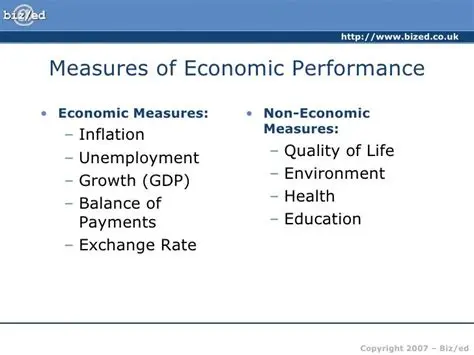When it comes to understanding the overall health and performance of an economy, there are several key measures that economists and policymakers look at. In this blog post, we’ll explore some of the most important indicators that are used to gauge the strength and stability of an economy. From the widely cited Gross Domestic Product (GDP) to the Consumer Price Index (CPI) and the Unemployment Rate, we’ll break down what each of these measures tells us about the economy. Additionally, we’ll delve into the significance of Income Inequality and the Labor Force Participation Rate, and how these factors can provide valuable insights into the overall wellbeing of a country’s economy. By the end of this post, you’ll have a better grasp of the various metrics that are used to assess the economy’s performance and gain a deeper understanding of the factors that can impact economic health.
Gross Domestic Product (GDP)
The Gross Domestic Product (GDP) is a key indicator of a country’s economic health, representing the total value of all goods and services produced within its borders over a specific period of time. It is often used to gauge the size and health of a country’s economy, as well as its overall growth rate. GDP can be calculated using three different approaches – the production approach, the income approach, and the expenditure approach. Each of these methods provides a different perspective on the economy and is used to ensure accuracy in the overall GDP figure.
One of the primary uses of GDP is to compare the economic performance of different countries. By analyzing the GDP of various nations, economists and policymakers can gain insights into the relative economic strengths and weaknesses of each country. Additionally, GDP is a crucial tool in assessing changes in the standard of living and economic well-being over time. An increase in GDP typically indicates a growing economy and higher income, while a decrease may signal downturns or recessions.
It is important to note that while GDP provides valuable information about the size and growth of an economy, it does not measure the overall well-being or happiness of a population. It is essential to consider other factors, such as income distribution, healthcare, education, and environmental sustainability, to gain a more comprehensive understanding of a society’s economic and social health. In conclusion, while GDP is a valuable tool for understanding a country’s economic performance, it should be used in conjunction with other indicators for a complete assessment of a nation’s well-being.
In summary, the Gross Domestic Product (GDP) is a critical measure of a country’s economic output and growth. It is used to compare the economic performance of different countries, gauge changes in standard of living, and assess the overall health of an economy. However, it is essential to recognize that GDP alone does not provide a complete picture of a nation’s well-being, and should be considered alongside other factors for a comprehensive understanding of economic and social health.
Consumer Price Index (CPI)
The Consumer Price Index (CPI) is a key measure of inflation that tracks the changes in the prices of a basket of goods and services over time. It is widely used by economists and policymakers to assess changes in the cost of living and to make adjustments in economic policies.
The CPI is calculated by taking price changes for each item in the predetermined basket of goods and averaging them. This basket typically includes food, housing, clothing, transportation, and medical care. The CPI provides valuable insights into the overall cost of living, as well as the rate of inflation in an economy.
Tracking the CPI is important for both individuals and businesses. For individuals, it helps to make informed decisions about budgeting and saving. For businesses, it provides insight into consumer spending patterns and overall market conditions.
Overall, the Consumer Price Index (CPI) is an important economic indicator that provides valuable information about the purchasing power of consumers and the overall health of the economy. Keeping a close eye on the CPI can help individuals and businesses make more informed financial decisions in a constantly changing economic environment.
Unemployment Rate
The unemployment rate is a key indicator of the health of an economy. It represents the percentage of the total labor force that is unemployed and actively seeking employment. This rate is often used to gauge the overall strength of the job market and can have significant implications for consumer spending and overall economic growth.
When the unemployment rate is high, it can lead to lower consumer confidence and decreased spending, as individuals may be more cautious with their finances. High unemployment can also indicate underlying issues within the economy, such as a lack of job opportunities or structural issues within certain industries.
Conversely, a low unemployment rate can be a sign of a strong and healthy job market, with ample opportunities for individuals to find work. This can lead to increased consumer confidence and higher levels of spending, which can in turn contribute to economic growth.
Policy makers and economists closely monitor the unemployment rate to assess the overall health of the economy and make informed decisions about monetary and fiscal policy. By understanding the factors that contribute to changes in the unemployment rate, policymakers can work to address issues such as job creation, education and training programs, and support for industries facing labor market challenges.
Income Inequality
Income inequality refers to the uneven distribution of income among a population. It is a measurement of the gap between the richest and poorest members of society. This issue has become increasingly prominent in discussions about economic and social policies, as the gap between the wealthy and the poor continues to widen.
One of the key factors contributing to income inequality is the disparity in wages and salaries. In many countries, the top earners make significantly more money than the average worker, leading to a concentration of wealth in fewer hands. This can create social unrest and dissatisfaction, as those at the bottom of the income distribution struggle to make ends meet while a small percentage of the population enjoys vast wealth.
Furthermore, income inequality can also have wide-ranging effects on the economy as a whole. When a large portion of the population is unable to afford basic necessities and is unable to participate fully in the economy, it can lead to decreased consumer spending, lower economic growth, and increased dependence on social welfare programs.
Addressing income inequality requires a multi-faceted approach, including policies aimed at increasing the minimum wage, providing access to affordable education and healthcare, and implementing progressive tax systems. By taking steps to reduce income inequality, countries can foster a more equitable society and ensure that all members have the opportunity to thrive.
Labor Force Participation Rate
The Labor Force Participation Rate is an important economic indicator that measures the proportion of the working-age population that is either employed or actively seeking employment. It provides valuable insight into the health of the labor market and the overall strength of the economy.
When the labor force participation rate is high, it typically indicates a strong and robust economy with ample job opportunities and a high level of engagement in the workforce. On the other hand, a low labor force participation rate can signal economic challenges such as structural unemployment, discouraged workers, or a shrinking labor force.
For policymakers and economists, the labor force participation rate is a crucial metric for understanding the dynamics of the labor market and making informed decisions about employment policies and programs. It can also provide insights into demographic trends, such as the impact of an aging population or changes in cultural attitudes towards work.
In summary, the labor force participation rate is a valuable tool for assessing the state of the labor market and the broader economy. By tracking changes in this indicator over time, policymakers and analysts can gain a better understanding of the underlying trends and challenges facing the workforce, and develop targeted strategies to address them.
Frequently Asked Questions
What is Gross Domestic Product (GDP)?
GDP is a measure of the total economic output of a country, including the value of all goods and services produced within its borders.
How is Consumer Price Index (CPI) calculated?
CPI measures the average change over time in the prices paid by urban consumers for a market basket of consumer goods and services. It is calculated by comparing the cost of the basket in a base period to the cost of the same basket in the current period.
What does the Unemployment Rate measure?
The unemployment rate measures the percentage of the total labor force that is unemployed and actively seeking employment.
How is Income Inequality measured?
Income inequality is often measured using indicators such as the Gini coefficient, which quantifies the extent of income distribution within a country.
What does the Labor Force Participation Rate indicate?
The labor force participation rate measures the percentage of the population that is either employed or actively seeking employment, out of the total working-age population.
How do these measures impact the economy’s overall performance?
These measures provide valuable insights into the health of the economy, such as its productivity, price stability, employment opportunities, income distribution, and overall economic participation.
Why are these measures important for policymakers and economists?
Policymakers and economists use these measures to assess the current state of the economy, identify trends, and develop strategies to promote economic growth, stability, and equity.







